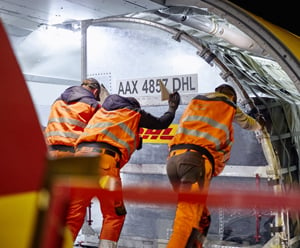デジタル化がいかにDHLエクスプレスのオペレーションに変化をもたらしたのか

DHLエクスプレスオペレーションセンターのAQCC(Advanced Quality Control Center)システムのダッシュボードには、一斉に赤い警告灯が点灯していますが、各施設の雰囲気は落ち着いています。
人工知能を利用したAQCCシステムのデータ分析能力は、出荷の動きを監視し、問題にリアルタイムでフラグを立てるように設計されており、完全に制御されています。
例外と呼ばれる、輸送中の停滞した貨物の位置はすばやく特定され、その予測ルートがマッピングされます。 チームのアナリストは、これらの貨物が時間どおりに目的地に到着できるように、是正措置を実施するために調査を行います。
一見簡単そうに見えるこの作業は、かつてはDHLエクスプレスのようなロジスティクスプロバイダーにとって骨の折れる仕事でしたが、デジタル化によって少しずつ状況が変わってきています。。
ロジスティクス業界は長い間、手作業や反復的な作業を伴う伝統的な産業として知られてきました。時代遅れのプロセスやITシステムに阻まれがちなロジスティクス企業は、急速に変化する業界で競争力を維持するために、テクノロジーを活用する必要性があります。
ドイツポストDHLグループ(DPDHLグループ)は、「デジタルの世界で卓越した価値を提供する」というストラテジー2025の目標に沿って、2021年から2025年にかけて20億ユーロ以上をデジタルトランスフォーメーションプロジェクトに投資し、お客様と従業員の体験を向上させるとともに、オペレーショナルエクセレンスを高めていきます。
DHLエクスプレスは、世界220以上の国・地域に広がる3,200の施設で、最高クラスのテクノロジーソリューションを駆使し、年間約5億個の貨物を輸送しています(2020年の数字による)。
動画を見る: ケン リー、アジア太平洋地域のデジタル化について
DHLエクスプレス、アジア太平洋地区のCEOのケン リーは、「常にお客様のニーズに耳を傾けることで、お客様、従業員、オペレーションにとって適切かつ賢明な技術革新を実現してきました。
私たちは、必要不可欠なプロセスを合理化し、時間のかかる反復作業を自動化するソリューションを導入し、生産性を向上させました。 例えば、無人搬送車によるオペレーションの強化、チャットボットによるカスタマーサービスの補完、貨物追跡センサーの導入などを行いました。」と述べています。
新型コロナウイルスによって、越境EC需要の急増に対応し、効率性と生産性の向上を推進するために、当社のデジタルトランスフォーメーションへの取り組みと投資が益々不可欠となっています。
「パンデミックが発生する前から、ロジスティクスプロバイダーとしてのサービスレベルを維持・向上させるためには、デジタルトランスフォーメーションが必須であることを認識していました。そしてパンデミックが発生したことで、従業員がどこにいてもバーチャルに協力して仕事ができるようにする計画が加速しました。 また、ライブチャットやデジタルアシスタントなどの技術の導入・展開を急ぎました。これらの技術は、世界的な未曾有の需要急増に対応するために不可欠なものでした」と、DHLエクスプレスアジア太平洋地区チーフインフォメーションオフィサーのジミー ヨーは説明しています。
デジタル化がDHLエクスプレスに与える影響をより深く理解するために、Logistics of Thingsでは、近年行われた注目すべきデジタルトランスフォーメーションプロジェクトを詳しく調べています。










 日本語
日本語